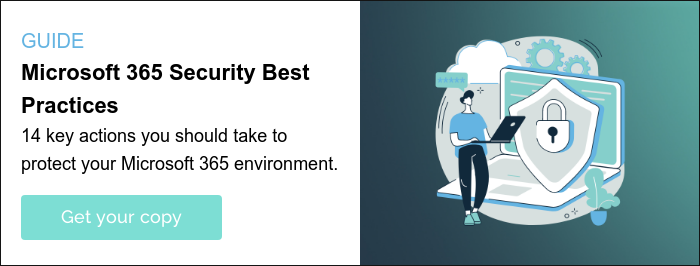5 Things You Must Do to Improve Microsoft 365 Security
Microsoft 365 provides a holistic approach to security, offering the tools you need to protect data, email, and identities. However, it’s not enough to simply have this system in place: It’s also essential to implement additional security controls to protect your Microsoft 365 environment.
Many cybercriminals target Microsoft 365 due to its popularity, making it vulnerable to ransomware, malware, and phishing attacks. While the platform has built-in protection to help keep your data secure, there are additional actions and tools that must be implemented.
So, how can you ensure the platform is well-protected? Let’s explore five Microsoft 365 security best practices that every organization should implement to reduce risk.
1. Implement Multifactor Authentication
No surprise here: Multifactor authentication (MFA) is absolutely vital to improving Microsoft 365 security posture. MFA ensures one of your most valuable assets—user credentials like admin accounts—has an extra layer of protection against cyberattacks. MFA, also known as two-step verification, requires users to sign into Microsoft 365 with a unique code sent to their mobile device through SMS text or an authenticator app.
A lapse in identity security can lead to a breach of the data and systems to which the user has access. It can also lead to phishing attacks leveraging the compromised account to access additional accounts and data. Hopefully, your organization already has MFA implemented, but as users come and go, it can be missed, so routinely check that MFA is registered for all users—including admins.
2. Enable Microsoft Defender for Office 365
Email continues to be the number one entry point for ransomware. Microsoft Defender for Office 365 unifies your incident response process and protects email and collaboration from zero-day malware, phishing, and business email attacks. First routing email messages and attachments to a detonation chamber, Defender then performs a behavior analysis to detect malicious intent. A detailed report after the threat allows you to investigate why it was flagged as well as detail who received the malicious emails and links.
Every Microsoft 365 subscription comes with basic email security built in, called Exchange Online Protection (EOP). But with Microsoft Defender for Office 365 Plan 2, you can extend that protection with advanced detection, investigation, and response. To go a step further, ProArch’s Managed Detection and Response services ingests alerts from Microsoft 365 and investigates and responds to malicious activity 24/7.
3. Configure Sign-In and User Risk Policies
With Azure Directory Identity Protection, you can detect potential risks associated with your Azure AD users, including sign-in risks that can be better protected through a prebuilt set of rules. Identity Protection analyzes signals from each sign-in and calculates a risk score based on the probability that the sign-in wasn’t performed by the user. This enables admins to be alerted of unusual activity and block suspicious users from accessing the system.
Sign-in and user risk policies can also be configured to take specific actions based on the associated risk like resetting a password or performing multifactor authentication.
4. Enable Audit Logging
Audit logging correlates information from across the Microsoft 365 environment to deliver insight into who is accessing or viewing documents if any policy violations or misuse occurs, as well as detect breaches when tied to a security monitoring tool. Audit logging is especially critical for investigating security incidents and demonstrating compliance. Depending on your logging requirements there are limitations with native logs, so you may need to supplement them with additional services and tools like Microsoft Purview.
5. Manage Global Administrative Privileges
Because admin accounts have elevated privileges, they are valuable targets for cyberattacks. A best practice is to assign two to four global admins. One admin allows an attacker to perform any malicious activity if the account is compromised without the possibility of being discovered by another admin. However, keeping admins below five is necessary to reduce the weaknesses exploitable by attackers who have gained access through a compromised account.
We recommend routinely reviewing global admin users and adjusting roles to access only what they need. For example, if you want someone to reset employee passwords, you should assign a limited admin role, like password administrator or helpdesk administrator.
Don’t avoid protecting your Microsoft 365 platform until it’s too late. As a top Microsoft Partner with deep experience in cybersecurity, ProArch's Microsoft Office 365 security solutions include a flat fee Microsoft 365 security review that will reveal risks and provide clear recommendations on how to harden your environment.
Contact us to start a conversation and in the meantime download our guide, Microsoft Office 365 Security Best Practices, for 10 more ways to lockdown your Microsoft 365 environment.

Director of Marketing Rebecca leads ProArch's marketing efforts, seamlessly blending technology and storytelling to assist clients in their buying journey. She is dedicated to presenting technological solutions in a compelling manner that drives significant growth for the company. Collaborating closely with sales, engineering, leadership, and HR teams, Rebecca sets the strategic vision for ProArch and ensures alignment across the organization. Her strategic, visionary, and detail-oriented approach shapes ProArch’s brand to be synonymous with reimagining technology to achieve business objectives.



